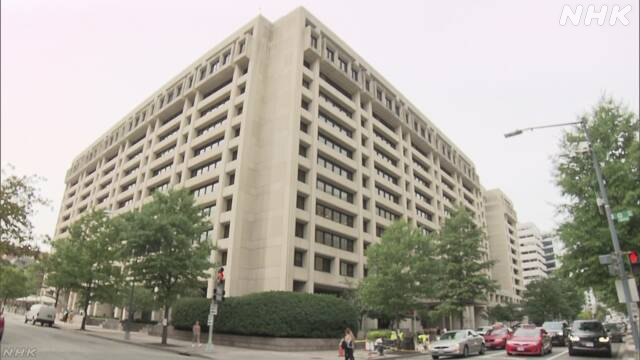This year's global economy is still harsh with upward revisions IMF October 14, 5:12
The IMF = International Monetary Fund has announced the latest outlook for the world economy this year, and has revised it upward from four months ago as economic activity is resuming in China and elsewhere.
However, the global growth rate is minus 4.4%, and Japan is minus 5.3%, which is still a difficult outlook.
On the 13th, the IMF announced the outlook for the global economic growth rate of the year, saying that it will increase by 0.8 points from the previous time, to minus 4.4%.
This is because each country has been hit by the spread of the new coronavirus, and personal consumption is recovering as economic activity resumes.
China is recovering faster, rising 0.9 points from the previous time to + 1.9%, the only major country or region to expect positive growth.
On the other hand, the United States, which has the highest number of infected people in the world, has been revised upward by 3.7 points to minus 4.3%, and Japan has been raised by 0.5 points to minus 5.3%, but the outlook remains severe.
In addition, Germany was raised by 1.8 points to minus 6.0%, and the United Kingdom was raised by 0.4 points to minus 9.8%.
In addition, India expects the spread to be reduced by 5.8 points to minus 10.3%, saying it has not stopped the spread.
On top of that, the impact of the economic downturn has been prolonged globally, and it is estimated that the economic loss for the six years until 2025 will be 28 trillion dollars, and the Japanese yen will be close to 3000 trillion yen.
"The virus has re-spread and some countries are moving to put strict restrictions on economic activity again," said IMF Director General Gita Gopinato at a press conference, cautious about future infections and economic implications. I showed the idea to look at.
Manhattan Building average vacancy rate of about 12%
In the United States, which has the highest number of people infected with the new coronavirus in the world, the status of resumption of economic activity varies from region to region, and especially in New York, where severe restrictions continue, brand stores and restaurants are being closed or withdrawn one after another.
On Fifth Avenue, where luxury brand stores in Manhattan are gathered, there are many buildings that are vacant with the signboard on the first floor removed, and the posters that recruit tenants are conspicuous.
Due to the rapid spread of the new coronavirus infection, the number of people working from home and moving to the suburbs has increased in Manhattan since March, and the restaurant business is still one-fourth of the normal number of seats. The background is that it is restricted to.
According to a private survey, the average vacancy rate of buildings in Manhattan from April to June has risen to about 12%, the lowest level in 16 years.
Aaron Weber, who owns 40 rental stores in Manhattan, says that over the past six months, sales of restaurants and bars have dropped sharply, and rent payments have been delayed.
However, even if the tenant evicts, there is no prospect of a new contract, and he is telling him not to evict even if he cannot pay the rent.
"It was a lively area, but it looks like a ghost town. If this situation continues, it will be very difficult. I just hope it will return to normal," said Weber.
Strict infection control against the background of China's economic recovery
In China, which is said to be suppressing the spread of the new coronavirus, the movement of people is becoming active.
According to the announcement by the Chinese government, a total of 637 million people went on domestic trips during the consecutive holidays that coincided with the National Day of the People's Republic of China from the 1st to the 8th of this month.
During this period, the total sales of major retail and food and beverage companies amounted to RMB1.6 trillion, or about 25 trillion yen in Japanese yen, which is 4.9% higher than last year on average per day.
During the holidays, the Forbidden City, a World Heritage Site in Beijing, was regaining its vibrancy with many tourists from all over China, despite continued restrictions on the number of visitors.
A man from Xi'an inland said, "I've been on a trip for the first time. Now I'm very happy to be able to come with my family without worrying about getting infected."
Behind the recovery of China's economy are strict measures against infectious diseases and aggressive economic measures by the government.
When a new person infected with the new coronavirus is found, the Chinese government says that it will block the area and conduct large-scale PCR tests to control the spread of the infection.
When a new infection was recently identified in Qingdao, Shandong Province, local authorities announced that they would perform a PCR test on more than 9 million citizens within five days.
In addition, as an economic measure, we are expanding infrastructure investment through aggressive fiscal mobilization, and we are working to raise the economy by subsidizing the purchase of automobiles by local governments.
As a result, industrial production in August increased by 5.6% compared to the same month last year and became positive for the fifth consecutive month, and the trend of recovery continues.
On the other hand, retail sales were positive for the first time in August, up 0.5% from the same month last year, but lacking strength and sustaining consumer spending. The issue is whether or not it can be recovered.

